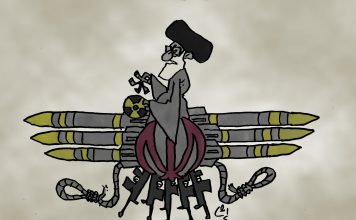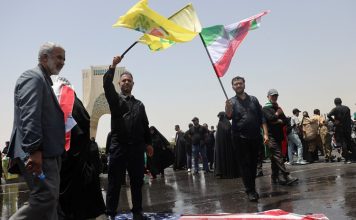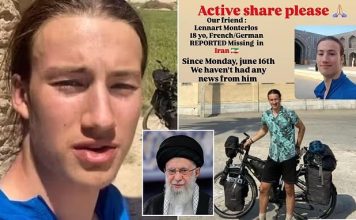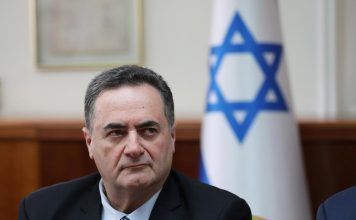By Kayhan Life Staff
The Islamic Revolutionary Guards Corps Qods Force (IRGC-QF) and a coalition of Shia militias led by Hezbollah are reportedly working with Islamic State (IS) forces in Syria, the UK-based Syrian Observatory for Human Rights (SOHR) said on July 14, citing unnamed sources.
SOHR said it had received documents from its sources showing that in April 2021, the IRGC had sent a message in Persian to a security unit operating under the Islamic Republic auspices, requesting that it open a channel of communication with IS through tribal intermediaries, including Bedouin leaders in Syria.
The letter highlighted the “common goal of war against Western occupation.”
The report added that on April 22, 2021, Sheikh Ali Ahmad al-Amuri, a spiritual leader of a Bedouin group in Hama (213 kilometers north of Damascus) with a long history of reportedly mediating between Iranian-backed militias and IS, had asked his long-time friend, Brigadier-General Ahmad Ibrahim Al-Khalil, a commander in the Syrian Army in Deir ez-Zor Governorate (in eastern Syria, bordering Iraq), for help which ultimately resulted in the IRGC and IS representatives agreeing to meet.
The meeting reportedly occurred on May 20, 2021, in the Syrian desert somewhere between Kabajib and Al-Sukhnah.
According to SOHR, a man named Haj Dehghan and someone called Abu Albra represented the IRGC and IS at the meeting.
[aesop_image img=”https://kayhanlife.com/wp-content/uploads/2023/07/haj-deghaghn-1.jpg” panorama=”off” credit=”A photo of so called Haj Dehghan. Kayhan Life can not confirm the accuracy of the image. KL./” align=”center” lightbox=”on” captionsrc=”custom” captionposition=”left” revealfx=”off” overlay_revealfx=”off”]
After reviewing the history of cooperation between the two organizations, Haj Dehghan reportedly guaranteed the delivery of weapons and munition to IS and safe passage for the group to territories controlled by the Syrian Democratic Forces (SDF, a coalition of ethnic militias and rebel groups in North and East Syria) in exchange for IS limiting its attacks on convoys of militias operating under the Islamic Republic auspices.
The report added that an IRGC delegation and IS representatives met at the same location nearly three weeks later. At the meeting, Abu Albra had set certain conditions before the two sides could work together. IS reportedly asked the IRGC for detailed information about the Al-Hasaka Prison in Ghuwayran, where several of its commanders were held. The prison is under the Syrian Democratic Force’s control.
In the days following the meeting, the IRGC reportedly supplied IS with detailed information about Al-Hasaka Prison and the surrounding region, including checkpoints, roads, and routes patrolled by forces opposing Bashar al-Assad. It would have been impossible for IS to collect such sensitive information without the help of the IRGC, the report said.
While IS reportedly reduced its attacks on forces stationed at IRGC military bases significantly, it escalated its fight against the Combined Joint Task Force (a multinational military formation or Coalition Forces) and the SDF in the east of the Euphrates.
From that point until July 2021, the Islamic Republic forces facilitated the safe passage of 500 IS combatants to regions under SDF control. SOHR said, citing its sources.
According to SOHR findings, to conduct its Al-Hasaka Prison operation in Ghuwayran, IS forces traveled on a major road near the Khabur River (the largest perennial tributary to the Euphrates in Syria), avoiding several checkpoints.
The night before the assault on Al-Hasaka Prison, IS forces reportedly stayed at an Iranian-backed militia base. A car loaded with explosives later used in the prison attack was being guarded at the base, SOHR said, citing its sources.
After the Al-Hasaka Prison operation, 200 IS fighters were freed, the report added.
SOHR also found that the IRGC and IS clashes have reduced significantly since then. However, over 200 operations were reportedly conducted in the regions controlled by the SDF and the Coalition Forces in 2022, which resulted in 300 civilian deaths, including women and children.
IS reportedly conducted 100 operations in the Syrian desert during the same period, six of which targeted Iranian-backed forces, killing at least 27 Shia militias, four of whom were members of the Fatemiyoun Brigade (Afghan Shia militias) and two belonged to the Zainabiyoon Brigade (Pakistani Shia militias), SOHR said.
ANALYSIS: Why Europe Is Unlikely to Designate IRGC As Terrorist Group
According to SOHR, in the middle of 2022, Iranian-backed militias informed IS they had received secret intelligence showing that the Coalition Forces and SDF planned to launch a new operation against IS east of Euphrates in the coming days.
IS reportedly used the information in an internal communique on Jan. 23, 2022, to order its fighters to withdraw from the region. A large segment of the group retreated with the help of Iran-backed militias from the east Euphrates to the desert, SOHR said.
SOHR noted that with the help of the Iran-backed militias, IS created a vast network of roads under its control in Syria, enabling it to conduct its operation with greater ease. The network reportedly includes a waterway between SDF forces and the Iran-backed militias allegedly used during the attack on Al-Hasaka Prison.
The report said IS used the waterway to transport its troops to and from the war zone. It also provided a route for IS to transfer the freed prisoners. The corridor is reportedly a strategic route for transferring IS troops and a perfect location for the group to conduct clandestine operations.
SOHR added that while the IRGC and Lebanese Hezbollah try to persuade the Syrian public of their “honorable intentions,” their sinister plans have been revealed to the Syrian people.
According to SOHR, the Islamic Republic’s main goal is to protect its interest in Syria, and it has no plan to end this calamity, and that is why it has no qualms working with IS, which has its hands drenched in the blood of the Syrian people.
“We would have killed half of [Iranian] people if we had dealt with the 1999 and 2009 riots in the same way, the Syrian army had treated its citizens,” Brigadier-General Mahmoud Chaharbaghi, former IRGC artillery commander in Syria, said in a speech on Sept. 28, 2019.
“The esteemed leader [Ayatollah Ali Khamenei] sent Haj Ghasem [Soleimani, former commander of the IRGC-QF] to save Bashar al-Assad.”
“God punished Iraq and made it an Iranian province,” Chaharbaghi added.
EU Can Proscribe Iran’s Revolutionary Guards Without Delay, Lawyers Say







